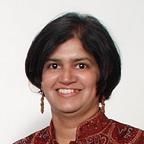Water’s Wonder Women
This International Women’s Day, CSEI pays tribute to Malin Falkenmark, Joan Rose and Sunita Narain
Illustrations by Sarayu Neelakantan
Water is essential for every aspect of human existence. On the one hand, populations and thirsty economies are still growing in much of the developing world. On the other, there is increasing consciousness on the need to preserve and sustain critical ecosystem services without which life on earth would not be possible.
In other words, we need water for ecosystems, cities, human health, and agriculture. And sometimes these needs can be at odds. Understanding how to meet these needs, in a sustainable yet equitable way primarily requires interdisciplinary research. But it also requires communicating science and aligning systems of policy and practice to implement solutions that reflect the ‘state of the science’.
Read | CSEI and Rural Water Security
Each year, the United Nations celebrates February 11 as the ‘International Day of Women and Girls in Science’, recognising that science and gender equality are both vital for the achievement of the Sustainable Development Goals. The day recognises that women are not merely passive recipients of making the world a better place but also agents of change capable of accelerating progress towards the achievement of the SDGs.
With the UN’s International Women’s Day on March 8 celebrating ‘gender equality today for a sustainable tomorrow’, we wanted to highlight three ‘wonder women of water’, who’s scientific achievements today are helping us achieve SDG6.
Prof. Malin Falkenmark
Professor Malin Falkenmark serves as Senior Scientific Advisor to the Stockholm International Water Institute (SIWI). She was awarded the Blue Planet Prize at the ripe age of 93 in 2018 and remains active! Trained as a hydrologist, she has had a long and illustrious career in interdisciplinary research, focusing on water scarcity and land-water-ecosystem linkages.
The Falkenmark Water Stress index offered a very simple way of measuring water stress to compare across regions and over time using universally available data. The index was first proposed in the 1970s and has since evolved, but the idea of developing indices that accounted for human demands on the water remains a key contribution.
Falkenmark coined the idea of ‘blue and green water’ in the early 1990s. Falkenmark and colleagues defined ‘green water’ as rainwater that infiltrates into the root zone and is taken up and evapotranspired by natural vegetation. ‘Blue water’ is defined as the water that either runs off or percolates beyond the root zone to form groundwater.
Blue water is the only form of water that is usable by us because it can be pumped and transported. In most watersheds (e.g. semi-arid places in India), almost 80% of the rainfall is green water and unavailable to humans, but nonetheless critical for sustaining forests, pastures, and rainfed agriculture.
Today, we take the concepts of water budgeting, soil moisture enhancements, and impacts of plantations on watersheds for granted. But before this, most textbooks, which were written from a civil engineers' perspective, who considered only blue water. Water resources were considered purely the province of civil engineers, who could harness and make it available for human use. The
Prof. Joan Rose
Prof. Joan Rose, a faculty at the Michigan State University won the 2016 Stockholm Water Prize, for her contributions to understanding microbial risks to human health in water systems.
Joan Rose, refers to her research team as water detectives. Together they are developing pioneering new methodologies for genetic analytics to understand waterborne health threats — sequencing virus DNA in water sources, discharges to detect and address threats to public health.
As cities expand and wastewater is generated, using treated or reclaimed water is becoming the norm. But there is always a concern that treated wastewater may be the very pathway of further spread of infectious diseases. The reason her work is so important is that it makes it possible to detect pathogens thus allowing safe reuse of wastewater to become a reality.
Dr. Rose has won many accolades over the years, but it is important to note that she won these not just for doing great science but developing the tools and guidelines required to give policy and regulatory life to the science.
Sunita Narain
Sunita Narain is the founder of the Delhi-based think tank, Centre for Science and Environment. While Narain is not a scientist, she is a masterful science communicator, who is able to collapse complex scientific concepts into simple principles that can be implemented.
Over the last four decades, she has repeatedly shown how decentralised water and wastewater management technologies can improve water security. One of the ways in which she did this was a careful compilation of case studies and evidence to show that these worked.
Narain also developed the guidelines, tools, and training materials required to ensure these technologies would actually be implemented. Today, via the Anil Agarwal Environmental Training Institute (AAETI) that she founded, hundreds of practitioners, designers, and urban planners receive training on new sustainable, nature-based approaches.
Thanks to the pioneering work of each of these women, we have the ability to reimagine water systems as more equitable, sustainable and safe.
Do you know women in the water sector? Help us shine a spotlight on their work this International Women’s Day through Twitter and LinkedIn.
To stay updated on our work, join our mailing list.
We would love to hear from you. To collaborate with us, write to csei.collab@atree.org.
